34: Outras Anomalias Penianas
Este capítulo levará aproximadamente 17 minutos para ler.
Introdução
Este capítulo tem como objetivo discutir outras afecções penianas que podem ser encontradas (além da hipospádia) e que podem potencialmente justificar intervenção ou correção cirúrgica. Estas incluem curvatura peniana, torção peniana, pênis enterrado e megaprepúcio congênito.
A curvatura peniana e a torção peniana podem estar associadas à hipospádia ou a outras condições urológicas; ou podem ser entidades isoladas. O termo curvatura peniana congênita tem sido usado de forma intercambiável como curvatura sem hipospádia, uretra curta congênita e curvatura peniana congênita na literatura. Snodgrass propôs que ‘curvatura sem hipospádia’ fosse substituída por ‘curvatura peniana congênita’ e assim será referida ao longo deste capítulo.1 Há graus variados de curvatura peniana congênita. Ela pode ser ventral, dorsal e lateral ou uma combinação das três.
A torção peniana é uma rotação anormal do corpo do pênis que ocorre com mais frequência no sentido anti-horário. A curvatura peniana congênita e a torção peniana também já foram relatadas como ocorrendo simultaneamente.2
Há apresentações variadas de pênis enterrado ou de megaprepúcio congênito. Essas condições podem variar no espectro em que se apresentam e são comumente confundidas com micropênis; no entanto, o tamanho do pênis geralmente é normal. Uma queixa principal pode ser dificuldade para urinar como resultado de aprisionamento de urina em meninos com megaprepúcio congênito. Há muitos termos e descritores que têm sido usados para descrever a condição: oculto, encoberto, pouco evidente, invisível, aprisionado e pênis enterrado, entre outros. Esses termos amplos e abrangentes correspondem à descrição da aparência do pênis, mas podem não definir a causa anatômica.3 Assim como ocorre com sua nomenclatura, muitas abordagens para sua correção foram documentadas.
Embriologia
Durante o seu crescimento, a genitália externa desenvolve-se rapidamente, o que pode resultar em grandes variações morfológicas.4 Entre a 4ª e a 7ª semanas de gestação, o tubérculo genital forma-se pela migração de mesênquima mesodérmico para a região craniana da membrana cloacal. A região caudal da membrana cloacal forma as pregas urogenitais. A membrana cloacal é uma estrutura de dupla camada, composta por uma endoderme e uma ectoderme. A partir da 7ª semana de gestação, ocorre a diferenciação da genitália externa no sexo masculino. É concluída até 16–17 semanas de gestação. O gene SRY no cromossomo Y sinaliza o desenvolvimento dos cordões sexuais primitivos para formar testículos. As células de Leydig nos testículos produzem testosterona, que é convertida em di-hidrotestosterona para promover o desenvolvimento da genitália externa masculina.5
No sexo masculino, os andrógenos levam o mesoderma do tubérculo genital a formar os corpos cavernosos e a glande do pênis. A uretra peniana proximal resulta da tubularização da endoderme. Isso contrasta com a uretra peniana distal, que ocorre como resultado de recanalização.6 Durante a 8ª semana de gestação, a ectoderme se desenvolve em pele peniana e prepúcio. Bellinger e Kaplan demonstraram que a curvatura peniana é um estado normal do desenvolvimento, com resolução até a 16ª semana de gestação,7,8
Curvatura Peniana Congênita
História
Nesbit descreveu pela primeira vez três casos de curvatura peniana congênita em 1965. Ele sugeriu que essa condição era secundária a comprimentos fasciais desproporcionais envolvendo os corpos cavernosos.9
A torção peniana congênita foi descrita pela primeira vez por Verneuil em 1857. Na época, desaconselhava-se a intervenção cirúrgica, pois as tentativas de mobilizar a pele não foram bem-sucedidas em corrigir o alinhamento espiral dos corpos cavernosos. Fevre descreveu uma técnica para correção da torção peniana em 1947, na qual ele removeu as cruras do púbis e as reinseriu em uma posição normal.10,11
Epidemiologia
Estudos iniciais observaram que a curvatura peniana congênita ocorre em 4–10% dos homens.12,13 A incidência de curvatura dorsal é baixa na ausência de hipospádia, com taxas de ~5% descritas.14
A incidência de torção peniana congênita varia de 1.5–27%.15,16 Torção peniana significativa de mais de 90 graus é menos frequente, afetando 0.7% dos recém-nascidos do sexo masculino.16
Patogênese
Em 1937, Young teorizou que a curvatura peniana era secundária a uma uretra congenitamente curta. O desenvolvimento anormal da fáscia periuretral foi proposto por Devine e Horton como causa.17 Kramer propôs que a desproporção dos corpos cavernosos contribuía para a curvatura peniana.13 Em sua série, Donnahoo observou curvatura peniana secundária ao tracionamento da pele e do dartos como a causa mais comum (65%), desproporção dos corpos cavernosos (28%) e uretra congenitamente curta (7%). Este estudo observou taxas de curvatura ventral (84%), dorsal (11%) e lateral (5%).12 Estudo histopatológico da placa uretral demonstrou a ausência de fibrose e displasia em amostras colhidas intraoperatoriamente.18 Essa evidência, entretanto, refuta a teoria de que bandas fibrosas causem curvatura peniana. Interrupção do desenvolvimento peniano enquanto o pênis apresenta uma curvatura fisiológica também foi proposta como causa de curvatura peniana persistente.7
A curvatura dorsal adquirida pode ocorrer como resultado de contração cicatricial ou de cicatrização anormal após uma circuncisão.19
A etiologia exata da torção peniana congênita é desconhecida. As teorias propostas incluem fixação anormal da pele, desenvolvimento assimétrico dos corpos cavernosos e defeito rotacional dos corpos cavernosos ou da glande.11,20
Avaliação e Diagnóstico
No paciente do sexo masculino com hipospádia, a presença de curvatura peniana congénita e torção peniana é frequentemente avaliada no intraoperatório após um teste de ereção artificial.
Em crianças sem hipospádia, é frequentemente a observação dos pais que suscita a preocupação com a curvatura peniana. Durante a adolescência, a curvatura peniana torna-se evidente após ereções naturais. Outra situação que pode levar à detecção dessas condições é um achado incidental durante um exame médico de rotina. Pode-se suspeitar de torção se a rafe peniana se desviar da linha média. A presença dessas condições, porém, é menos evidente em crianças com fimose fisiológica. A avaliação na clínica também pode ser limitada pela baixa cooperação do paciente e pelo habitus corporal.19 A avaliação intraoperatória da curvatura peniana é realizada por meio do teste de ereção artificial.
Uma classificação operatória da curvatura peniana congênita foi proposta por Devine e Horton em três categorias. Grupo I, secundária à deficiência do corpo esponjoso, fáscia de Dartos e fáscia de Buck; Grupo II devido à deficiência da fáscia de Dartos e da fáscia de Buck; e Grupo III envolvia apenas a fáscia de Dartos.17 Este sistema de classificação foi ampliado para incluir o Grupo IV, que representava a desproporção dos corpos cavernosos.13 Um sistema adicional de classificação operatória por Donnahoo et al descreveu três tipos de curvatura peniana congênita; Tipo I é a curvatura secundária à aderência cutânea (Figura 1) e (Figura 2) Tipo II deve-se a brida fascial, e Tipo III é resultado de desproporção dos corpos cavernosos.12
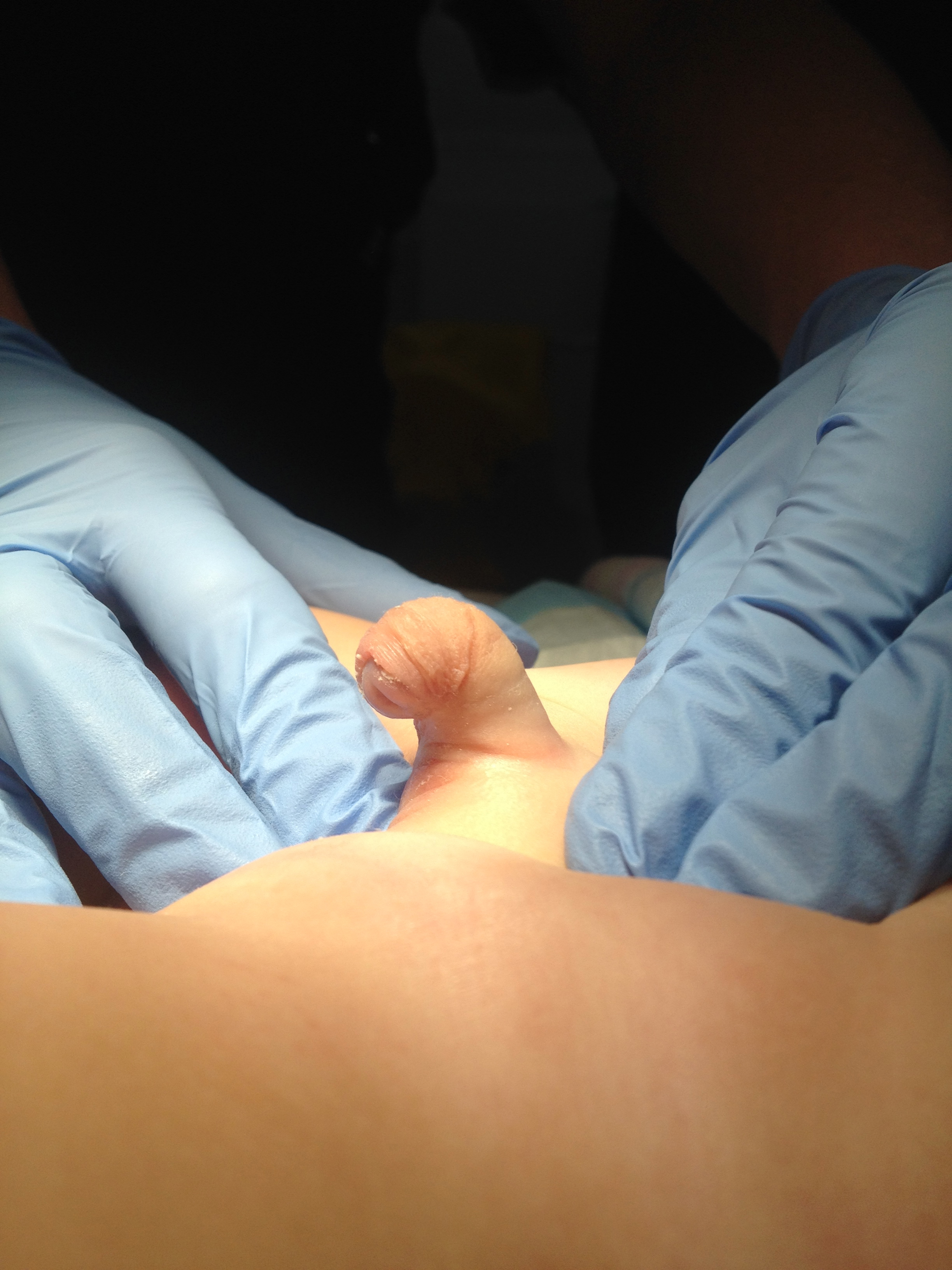
Figura 1 Curvatura tipo 1 com prepúcio em capuz e meato apical.
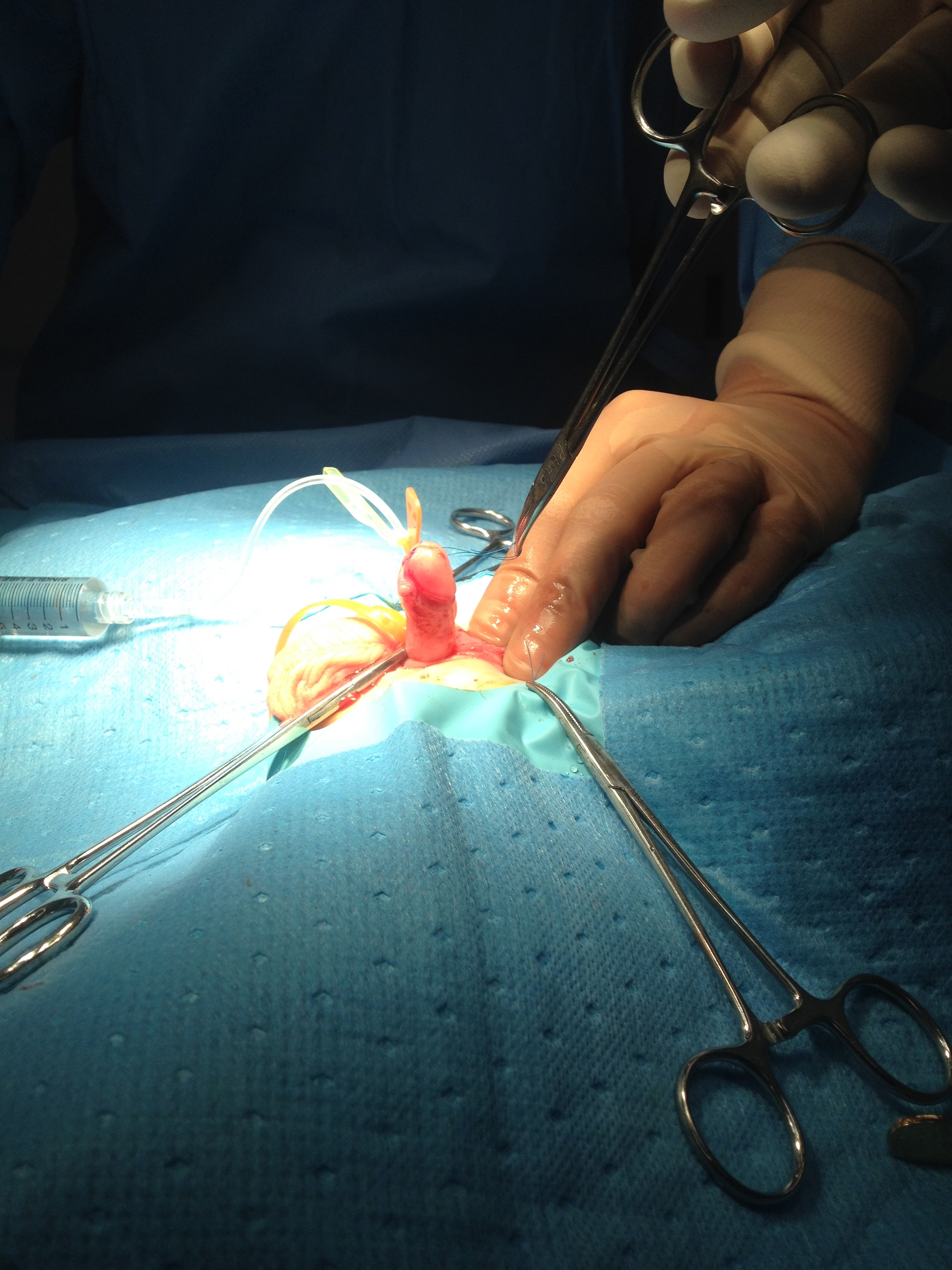
Figura 2 Teste de ereção após desenluvamento mostrando a curvatura corrigida.
Opções de Tratamento
Se diagnosticada precocemente, a correção cirúrgica da curvatura peniana congênita idealmente deve ocorrer durante o primeiro ano de vida.21 As opções cirúrgicas para o manejo da curvatura peniana dependem da gravidade, preferindo-se inicialmente a técnica menos invasiva.19 Uma pesquisa com urologistas pediátricos conduzida pela AAP constatou que curvaturas penianas de até 10 graus frequentemente eram deixadas sem tratamento. Curvaturas penianas maiores que 20–30 graus requerem intervenção; assim, essa gravidade foi rotulada como chordee significativa.22,23 A pesquisa constatou que qualquer curvatura peniana inferior a 50 graus era frequentemente tratada por plicatura dorsal, ao passo que curvaturas superiores a 50 graus comumente requeriam um procedimento de alongamento ventral.22
Na presença de inclinação da glande, recomenda-se inicialmente a liberação do frênulo como primeiro passo. O pênis é desenluvado até sua base para corrigir a fixação cutânea. Realiza-se um teste de ereção artificial para demonstrar a curvatura peniana persistente. Sugere-se plicatura para curvatura peniana residual de até 30 graus.1 A técnica de Nesbit foi um dos métodos mais antigos para corrigir a curvatura peniana. Ela envolvia a dissecção do feixe neurovascular dorsal dos corpos cavernosos, seguida de plicatura da túnica albugínea para corrigir a desproporção de comprimento existente em relação ao aspecto ventral. Posteriormente, essa técnica foi modificada após se observar recorrência e passou a incluir a excisão de uma cunha em forma de losango no ponto de curvatura máxima e a aposição transversal das bordas da túnica.9 Estudos neuroanatômicos demonstraram que os ramos nervosos para o pênis situam-se às 11 e 1 horas e se espalham ventralmente.5 Portanto, a plicatura dorsal na linha média é realizada na posição das 12 horas, evitando o feixe neurovascular. Essa área também é a região mais espessa e resistente da túnica.21,24 A utilização de um único ponto de plicatura ou de múltiplos pontos de plicatura permanece a critério do cirurgião.
Existem várias técnicas para tratar curvatura peniana maior que 30 graus, incluindo transecção da placa uretral e corporotomia ventral (com ou sem enxertia do defeito dos corpos cavernosos) e uretroplastia em estágios.1,13 Isso proporciona alongamento ventral para corrigir a desproporção dos corpos cavernosos. O enxerto dérmico inicial foi descrito por Devine e Horton.17
Para evitar a transecção da placa uretral, Mollard e Castagnola propuseram a dissecção da uretra dos corpos cavernosos subjacentes, além da plicatura dorsal.25 De forma semelhante, a dissecção da uretra dos corpos cavernosos foi realizada e estendida até a uretra bulbar.26
Curvatura peniana congênita foi tratada por Donnahoo et al utilizando mobilização completa da uretra com enxerto dérmico ventral.12 Isso foi semelhante à experiência de Tang em até um quarto dos seus pacientes.23
Outras técnicas para o manejo de apresentações complexas de curvatura peniana associadas à hipospádia ou epispádia incluem a dissociação dos corpos cavernosos e a desmontagem peniana e a enxertia com submucosa do intestino delgado,27,28,29,30
Modificação das técnicas Shaeer I e II precedentes, envolveu a rotação dos corpos cavernosos com fixação por sutura sem corporotomia.31
Argumenta-se que a correção da torção peniana é um procedimento estético, uma vez que o pênis permanece funcionalmente aceitável. Alguns autores defendem a correção da torção peniana se o grau de torção for superior a 45 graus. Existem múltiplas opções cirúrgicas para a correção da torção peniana. Foi proposto um procedimento cirúrgico em etapas que envolve desenluvamento peniano, um amplo retalho de rotação baseado no dartos, mobilização da placa uretral e do corpo esponjoso, mobilização da uretra proximal e mobilização da placa uretral/uretra hipoplásica com o corpo esponjoso até a glande.32,33 Um método adicional descrito é a sutura lateral da túnica albugínea ao periósteo púbico.20 Alguns descreveram o desenluvamento peniano e a reafixação da pele; no entanto, esses resultados nem sempre foram bem-sucedidos.20
Complicações
Complicações após a correção da curvatura peniana variam de 5% a 50% dependendo da gravidade da curvatura, com uma taxa geral de 8%, e incluem deiscência da glande, fístula uretrocutânea, curvatura recorrente e disfunção erétil, sendo estas as mais comuns,23,12,34
Complicações da correção da torção peniana incluem hematoma, torção peniana residual, redução da satisfação dos pais ou do paciente.35
Seguimento e Desfechos Sugeridos
A revisão pós-operatória inicial em ambulatório pode variar de seis a doze semanas, dependendo da preferência do cirurgião. Quanto à curvatura peniana, a avaliação é feita por meio da observação, pelos pais e/ou pelo paciente, das ereções naturais, além do exame físico no ambulatório. Há poucos estudos focados na duração adequada do acompanhamento pós-operatório.23
Megaprepúcio Congénito
História
A primeira descrição publicada de pênis enterrado foi por Keyes em 1919, onde ele descreveu que a condição surgia porque o pênis carecia de sua adequada ‘bainha de pele’ e permanecia ‘enterrado sob o tegumento do abdome, coxa ou escroto’.36,37 Desde 1919, houve vários relatos de caso documentados e discussões sobre este tema, com os pioneiros lançando as bases para o trabalho mais amplo que tem sido feito nos últimos vinte a trinta anos. Campbell, em 1951, descreveu “pênis oculto” como “um órgão rudimentar oculto sob a pele do escroto, períneo, abdome inferior ou coxa, nos tecidos adiposos que podem ser incomumente espessos”, Glanz, em 1968, relatou um caso em um adulto, Warkany, em 1971, descreveu um “micropênis ou pênis oculto”. Williams, em 1974, descreveu e ilustrou com um exemplo. Em 1977, além de descrever seus seis casos, Crawford propôs a primeira classificação para pênis enterrado.38
Curiosamente, dois relatos seminais iniciais incluíam estudos radiológicos. Em 1974, Gwinn e colegas descreveram, em seu “caso radiológico do mês”, um menino de 18 meses que se submeteu a uma urografia intravenosa para estadiamento do linfoma de Hodgkin. Durante a fase miccional, observaram que “todo o contraste na bexiga desceu para uma acentuada distensão bulbosa do prepúcio”.
Embora não o tenham nomeado especificamente, seu relato provavelmente fornece a primeira descrição de um megaprépucio.39,40 Vinte anos depois, em 1994, O’Brien et al relataram o caso de um menino de onze meses em quem se observou uma “grande tumefação esferoidal, aproximadamente do tamanho de uma laranja” e cuja mãe “demonstrou como a tumefação podia ser prontamente esvaziada por compressão manual”. Na uretroscopia, não conseguiram encontrar o meato devido ao prepúcio redundante. Foi colocado um cateter suprapúbico e realizado um cistograma miccional. Além de demonstrar bexiga e uretra normais, observou-se que o contraste fluía para uma grande bexiga prepucial com capacidade tão grande quanto a de sua bexiga urinária”. Eles cunharam o termo megaprépucio congênito para descrever isso, o que foi o primeiro uso documentado,40,41
Epidemiologia
A incidência exata do pênis inconspícuo é desconhecida. No entanto, tem sido proposto que se trata de uma condição emergente.42 Em uma revisão recente da literatura, o número de casos variou de 1 a 134 pacientes, com idades entre 2 meses e 33 anos. Em média, a cirurgia foi realizada antes dos 24 meses de idade.43
Patogênese
Pênis inconspícuo pode desenvolver-se como resultado de múltiplos fatores em vez de um único. Isso pode incluir deficiência de pele peniana, fixação anormal da pele do corpo peniano na base do pênis, pele peniana tracionada anteriormente devido a dartos disgenético e coxim adiposo pré-púbico proeminente. Causas secundárias resultam de complicações de cicatrização cicatricial após circuncisão ou de uma hérnia volumosa ou hidrocele.44
A etiologia exata do megaprepúcio congênito não é compreendida, mas a teoria amplamente proposta é que resulta dos efeitos de fixação do dartos anormal sobre o corpo do pênis. Isso é corroborado por abordagens iniciais para a correção do pênis enterrado, que observaram que a correção do defeito foi alcançada com sucesso por meio da ressecção do tecido do dartos. Um estudo prospectivo que avaliou a histologia do dartos observou que quase 80% dos pacientes apresentavam tecido do dartos anormal que ou tinha fibras musculares lisas pouco desenvolvidas ou fibras musculares lisas distribuídas aleatoriamente. Curiosamente, pacientes com pênis enterrado tinham maior probabilidade de apresentar dartos anormal em comparação com o grupo com hipospádia (78% em comparação com 70%).45 O aumento do volume de urina após o período neonatal e um jato miccional anormal devido a um orifício prepucial estreito são o que contribui para o efeito de balonização da condição.46
Avaliação e Diagnóstico
É importante distinguir entre um pênis de tamanho normal que está oculto e um micropênis. Esta é a avaliação inicial necessária, pois a conduta é bastante diferente para ambos. O primeiro necessitará de acompanhamento contínuo e, muito provavelmente, de intervenção cirúrgica com o urologista, enquanto o segundo exigirá avaliação adicional e cuidados combinados com a equipe de Endocrinologia e Genética. Este capítulo não abordará o manejo do micropênis.
Crawford foi o primeiro a classificar o pênis enterrado em oculto, enterrado e com prega penoescrotal.38 Maizels et al descreveram as diferentes etiologias como: enterrado, com prega penoescrotal, aprisionado ou micro/ diminuto. Essa classificação tem sido a mais amplamente utilizada, pois abrange os grupos nos quais a criança pode se enquadrar com base no exame clínico.47 Ao descrever sua abordagem cirúrgica (V-plastia ventral) para a correção do megaprepúcio congênito, Alexander e colegas sugeriram uma classificação com descrição anatômica mais precisa e a potencial causa subjacente (Figura 3), (Figura 4), (Figura 5), (Figura 6), e (Figura 7)3
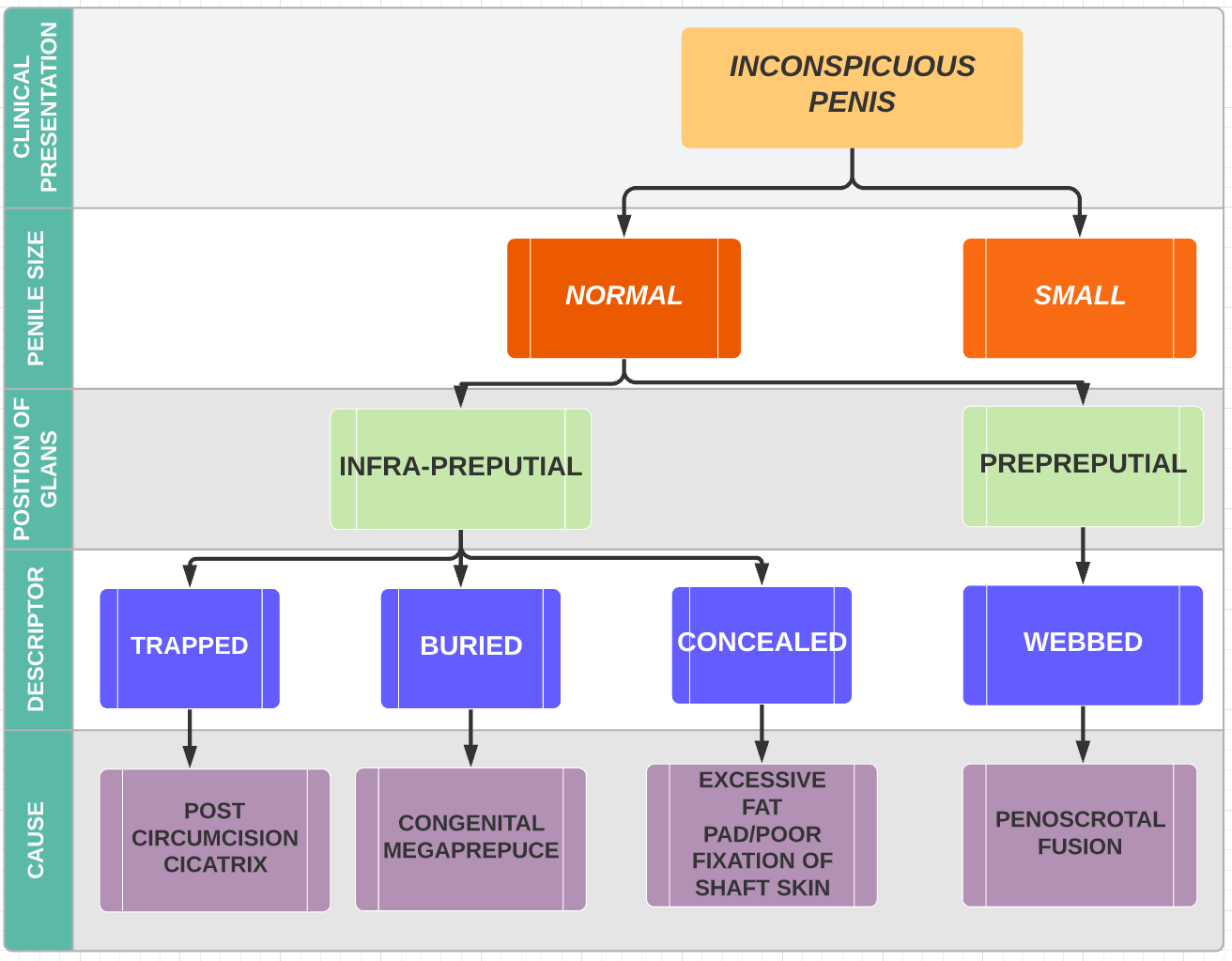
Figura 3 Classificação das causas de um pênis inconspícuo (Alexander et al).

Figura 4 Pênis aprisionado após circuncisão
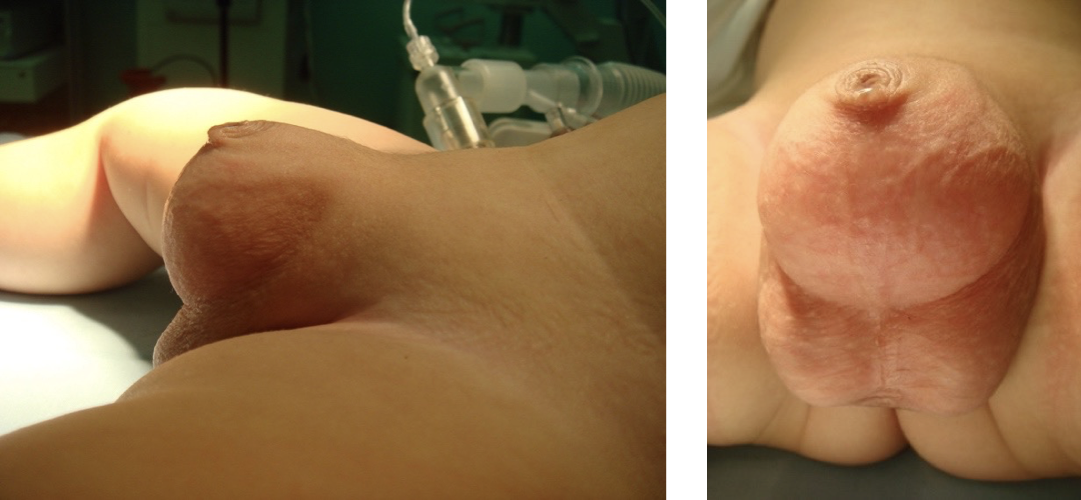
Figura 5 Megaprepúcio congênito
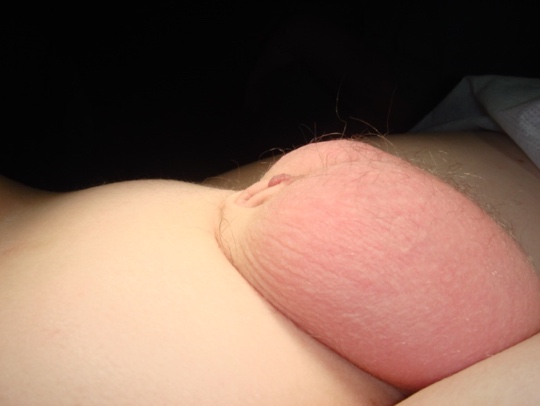
Figura 6 Pênis oculto
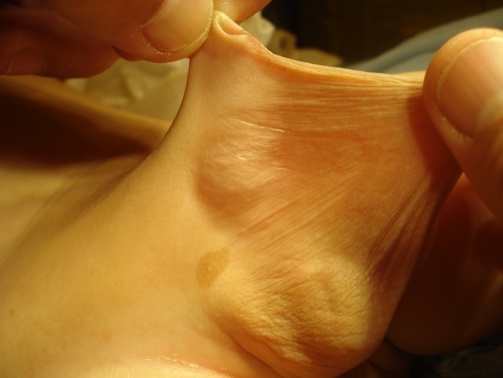
Figura 7 Fusão penoescrotal
Hadidi propôs dividir os pacientes com pênis enterrado em três grupos de acordo com os achados intraoperatórios. Grau 1 – pacientes com prepúcio interno anormalmente longo (LIP), Grau 2 – LIP e inserções distais anormais dos ligamentos fundiforme e suspensor no terço médio do corpo peniano, Grau 3 – Graus 1 e 2 mais excesso de gordura suprapúbica.37
Opções de tratamento
Várias abordagens cirúrgicas foram descritas para o desenterramento e a correção deste grupo de condições. O momento exato para a cirurgia tem sido uma questão controversa e é essencialmente influenciado pela causa subjacente. Os defensores da intervenção precoce apresentam razões semelhantes às do momento da correção da hipospádia – a intervenção precoce (6-12 meses de idade) é aconselhável para evitar consequências psicológicas.44,48 Os que são sintomáticos (retenção urinária, balanite recorrente, infecções do trato urinário) beneficiarão de cirurgia mais precoce. Outros autores recomendam a correção cirúrgica assim que o diagnóstico é feito para resolver tanto os aspectos urinários como os cosméticos,49,50 Por outro lado, a correção de um pênis oculto resultante de um proeminente coxim adiposo pré-púbico pode ser adiada, pois pode melhorar espontaneamente com o tempo, com Donahoe e Keating descrevendo que uma cobertura cutânea adequada do corpo peniano foi observada com as ereções.51
Há uma variedade de publicações e técnicas que descrevem a correção do megaprepúcio congênito.3,42,43,46,52 As principais etapas cirúrgicas estão listadas abaixo, com variações na forma como cada etapa é realizada, o que leva à diversidade de técnicas. Elas podem ser classificadas predominantemente em abordagem em tempo único (a maioria das técnicas) ou em dois tempos. Neste último, realiza-se inicialmente uma preputioplastia, com reavaliação posterior da anatomia após o treinamento esfincteriano.
As etapas cirúrgicas são:
- Remoção do anel estenótico ou fimótico
- Desdobramento do prepúcio
- Ressecção ou redução do folheto interno redundante do prepúcio
- Excisão do músculo dartos com displasia
- Recriação do ângulo penopúbico e penoescrotal mediante fixação da derme do corpo peniano à fáscia de Buck às 4 e 8 horas
- Cobertura do corpo peniano–a maioria das técnicas difere quanto ao tecido usado para cobrir o corpo peniano. Isso pode ser obtido utilizando pele peniana, o folheto interno redundante do prepúcio ou uma combinação de ambos.
É nossa preferência utilizar a abordagem anatômica, pois tivemos bons resultados em nossa experiência (Figura 8),52,53
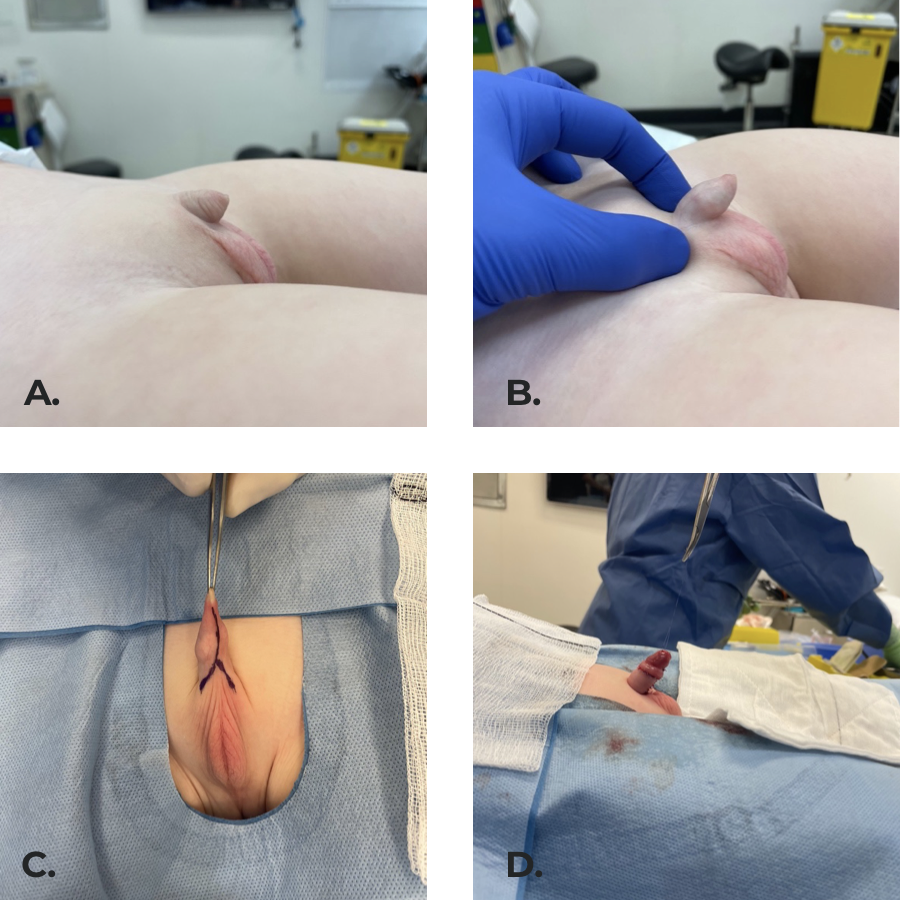 Figura 8 Pênis inconspícuo secundário à fusão penoescrotal e ângulo peno-púbico mal definido. (b) pênis exposto no exame. (c) Incisões cirúrgicas marcadas. (d) Resultado final com o corpo peniano coberto por pele, ângulos púbico e escrotal criados fixando a derme à fáscia de Buck às 4 e 8 horas.
Figura 8 Pênis inconspícuo secundário à fusão penoescrotal e ângulo peno-púbico mal definido. (b) pênis exposto no exame. (c) Incisões cirúrgicas marcadas. (d) Resultado final com o corpo peniano coberto por pele, ângulos púbico e escrotal criados fixando a derme à fáscia de Buck às 4 e 8 horas.
Complicações
As complicações pós-operatórias de curto prazo são hematoma, deiscência da ferida e edema peniano / escrotal. As complicações de médio a longo prazo incluem a necessidade de reoperação por linfoedema levando a excesso de pele prepucial interna, estenose do meato e retração do pénis,3,42,46,52,54
Acompanhamento e Desfechos Sugeridos
Dado que algumas das complicações têm sido relatadas mais tardiamente na vida, recomenda-se seguimento a longo prazo para esses pacientes. Shalaby e Cascio relataram uma mediana de seguimento de 17 a 61 meses.40
Conclusões
As condições penianas congênitas são incomuns; portanto, recomenda-se o encaminhamento a um urologista pediátrico para diagnóstico e manejo adequados.
Pontos-chave
- Recomenda-se a correção cirúrgica para curvatura peniana congênita maior que 20 graus
- Uma abordagem em etapas, com proteção das estruturas neurovasculares e preservação da placa uretral, é preferível ao reparar a curvatura peniana (sem hipospádia)
- Considere a correção da torção peniana maior que 45 graus
- A excisão da fáscia de Dartos displásica e a fixação da pele à fáscia de Buck são etapas fundamentais ao corrigir um megaprepúcio congênito
- Limite a excisão de pele até que seja assegurada cobertura adequada do corpo peniano
- O manejo inicial não operatório é preferível para o pênis oculto
Leituras recomendadas
- Mingin G, Baskin LS. Management of chordee in children and young adults. Urol Clin North Am 2002; 29 (2): 277–284, DOI: 10.1016/s0094-0143(02)00044-7.
- Smeulders N, Wilcox DT, Cuckow PM. The buried penis-an anatomical approach. BJU Int 2000; 86 (4): 523–526, DOI: 10.1046/j.1464-410x.2000.00752.x.
- Alexander A, Lorenzo AJ, Salle JLP, Rode H. The Ventral V-plasty: a simple procedure for the reconstruction of a congenital megaprepuce. J Pediatr Surg 2010; 45 (8): 1741–1747, DOI: 10.1016/j.jpedsurg.2010.03.033.
- Shalaby M, Cascio S. Megaprepuce: a systematic review of a rare condition with a controversial surgical management. Pediatr Surg Int 2021; 37 (6): 815–825, DOI: 10.1007/s00383-021-04883-5.
Referências
- Snodgrass WT. Management of penile curvature in children. Curr Opin Urol 2008; 18 (4): 431–435, DOI: 10.1097/mou.0b013e32830056d0.
- Slawin KM, Nagler HM. Treatment of congenital penile curvature with penile torsion: a new twist. J Urol 1992; 147 (1): 152–154, DOI: 10.1016/s0022-5347(17)37169-0.
- Alexander A, Lorenzo AJ, Salle JLP, Rode H. The Ventral V-plasty: a simple procedure for the reconstruction of a congenital megaprepuce. J Pediatr Surg 2010; 45 (8): 1741–1747, DOI: 10.1016/j.jpedsurg.2010.03.033.
- Gredler ML. Evolution of external genitalia: insights from reptilian development. Sex Dev 2014; 8 (5): 311–326, DOI: 10.1159/000365771.
- Yiee JH, Baskin LS. Penile embryology and anatomy. ScientificWorldJournal 2010; 10: 1174–1179, DOI: 10.1100/tsw.2010.112.
- Baskin L. Development of the human penis and clitoris. Differentiation 2018; 103: 74–85, DOI: 10.1016/j.diff.2018.08.001.
- Kaplan GW, Lamm DL. Embryogenesis of chordee. J Urol 1975; 114 (5): 769–772, DOI: 10.1016/s0022-5347(17)67140-4.
- Bellinger MF. Embryology of the Male External Genitalia. Urologic Clinics of North America 1981; 8 (3): 375–382, DOI: 10.1016/s0094-0143(21)01293-3.
- Nesbit RM. CONGENITAL CURVATURE OF THE PHALLUS: REPORT OF THREE CASES WITH DESCRIPTION OF CORRECTIVE OPERATION. J Urol 1965; 93: 230–232, DOI: 10.1016/s0022-5347(17)63751-0.
- Fevre. Treatment of bends and twists of the penis. Sem Hop 1947; 23 (14): 895,.
- Azmy A, Eckstein HB. Surgical correction of torsion of the penis. Br J Urol 1981; 53 (4): 378–379, DOI: 10.1111/j.1464-410x.1981.tb03202.x.
- Donnahoo KK. Etiology, management and surgical complications of congenital chordee without hypospadias. J Urol 1998; 160 (3 Pt 2): 1120–1122, DOI: 10.1016/s0022-5347(01)62713-7.
- Kramer SA, Aydin G, Kelalis PP. Chordee without hypospadias in children. J Urol 1982; 128 (3): 559–561, DOI: 10.1016/s0022-3468(83)80141-9.
- Kelâmi A. Classification of Congenital and Acquired Penile Deviation. Urologia Internationalis 1983; 38 (4): 229–233, DOI: 10.1159/000280897.
- Sarkis PE, Sadasivam M. Incidence and predictive factors of isolated neonatal penile glanular torsion. J Pediatr Urol 2007; 3 (6): 495–499, DOI: 10.1016/j.jpurol.2007.03.002.
- Ben-Ari J, Merlob P, Mimouni F, Reisner SH. Characteristics of the male genitalia in the newborn: penis. J Urol 1985; 134 (3): 521–522, DOI: 10.1016/s0022-5347(17)47272-7.
- Devine CJ Jr, Horton CE. Chordee without hypospadias. J Urol 1973; 110 (2): 264–271, DOI: 10.1016/s0022-5347(17)60183-6.
- Snodgrass W, Patterson K, Plaire JC, Grady R, Mitchell ME. Histology of the urethral plate: implications for hypospadias repair. J Urol 2000; 164 (3 Pt 2): 988–989 989–990, DOI: 10.1097/00005392-200009020-00017.
- Montag S, Palmer LS. Abnormalities of penile curvature: chordee and penile torsion. ScientificWorldJournal 2011; 11: 1470–1478, DOI: 10.1100/tsw.2011.136.
- Zhou L, Mei H, Hwang AH, Xie H-W, Hardy BE. Penile torsion repair by suturing tunica albuginea to the pubic periosteum. J Pediatr Surg 2006; 41 (1): 7–9, DOI: 10.1016/j.jpedsurg.2005.10.065.
- Mingin G, Baskin LS. Management of chordee in children and young adults. Urol Clin North Am 2002; 29 (2): 277–284, DOI: 10.1016/s0094-0143(02)00044-7.
- Bologna RA, Noah TA, Nasrallah PF, McMahon DR. Chordee: varied opinions and treatments as documented in a survey of the American Academy of Pediatrics, Section of Urology. Urology 1999; 53 (3): 608–612, DOI: 10.1016/s0090-4295(98)00656-6.
- Tang Y-M, Chen S-J, Huang L-G, Wang M-H. Chordee without hypospadias: report of 79 Chinese prepubertal patients. J Androl 2007; 28 (4): 630–633, DOI: 10.2164/jandrol.106.002436.
- Baskin LS, Erol A, Li YW, Cunha GR. Anatomical studies of hypospadias. J Urol 1998; 160 (3 Pt 2): 1108–1115. DOI: 10.1016/s0022-5347(01)62711-3.
- Mollard P, Castagnola C. Hypospadias: the release of chordee without dividing the urethral plate and onlay island flap (92 cases. J Urol 1994; 152 (4): 1238–1240, DOI: 10.1016/s0022-5347(17)32557-0.
- Bhat A. Extended urethral mobilization in incised plate urethroplasty for severe hypospadias: a variation in technique to improve chordee correction. J Urol 2007; 178 (3 Pt 1): 1031–1035, DOI: 10.1016/j.juro.2007.05.074.
- Koff SA, Eakins M. The treatment of penile chordee using corporeal rotation. J Urol 1984; 131 (5): 931–932, DOI: 10.1016/s0022-5347(17)50716-8.
- Perovic SV, Djordjevic ML. A new approach in hypospadias repair. World J Urol 1998; 16 (3): 195–199, DOI: 10.1007/s003450050052.
- Ballesteros N. Use of small intestinal submucosa for corporal body grafting in cases of epispadias and epispadias/exstrophy complex. J Pediatr Urol 2019; 15 (4): 406 1–406 6, DOI: 10.1016/j.jpurol.2019.05.024.
- Castellan M, Gosalbez R, Devendra J, Bar-Yosef Y, Labbie A. Ventral corporal body grafting for correcting severe penile curvature associated with single or two-stage hypospadias repair. J Pediatr Urol 2011; 7 (3): 289–293, DOI: 10.1016/j.jpurol.2011.03.008.
- Shaeer O, Shaeer K. Shaeer’s Corporal Rotation III: Shortening-Free Correction of Congenital Penile Curvature-The Noncorporotomy Technique. Eur Urol 2016; 69 (1): 129–134, DOI: 10.1016/j.eururo.2015.08.004.
- Bhat A, Bhat MP, Saxena G. Correction of penile torsion by mobilization of urethral plate and urethra. J Pediatr Urol 2009; 5 (6): 451–457, DOI: 10.1016/j.jpurol.2009.05.013.
- Fisher PC, Park JM. Penile torsion repair using dorsal dartos flap rotation. J Urol 2004; 171 (5): 1903–1904, DOI: 10.1097/01.ju.0000120148.79867.5c.
- Badawy H, Morsi H. Long-term followup of dermal grafts for repair of severe penile curvature. J Urol 2008; 180 (4 Suppl): 1842–1845, DOI: 10.1016/j.juro.2008.04.082.
- Bar-Yosef Y, Binyamini J, Matzkin H, Ben-Chaim J. Degloving and realignment-simple repair of isolated penile torsion. Urology 2007; 69 (2): 369–371, DOI: 10.1016/j.urology.2007.01.014.
- Keyes EL, Others. Phimosis, paraphimosis, tumors of the penis. Urology 1919; 67: 649,.
- Hadidi AT. Buried penis: classification surgical approach. J Pediatr Surg 2014; 49 (2): 374–379, DOI: 10.1016/j.jpedsurg.2013.09.066.
- Crawford BS. Buried penis. Br J Plast Surg 1977; 30 (1): 96–99, DOI: 10.1016/s0007-1226(77)90046-7.
- Gwinn JL, Lee FA, Haber K. Radiological case of the month. Unusual presentation of phimosis. Am J Dis Child 1974; 128 (6): 835–836,.
- Shalaby M, Cascio S. Megaprepuce: a systematic review of a rare condition with a controversial surgical management. Pediatr Surg Int 2021; 37 (6): 815–825, DOI: 10.1007/s00383-021-04883-5.
- O’Brien A, Shapiro AM, Frank JD. Phimosis or congenital megaprepuce? Br J Urol 1994; 73 (6): 719–720, DOI: 10.1111/j.1464-410x.1995.tb07856.x.
- Summerton DJ, McNally J, Denny AJ, Malone PS. Congenital megaprepuce: an emerging condition-how to recognize and treat it. BJU Int 2000; 86 (4): 519–522, DOI: 10.1111/j.1464-410x.2001.0003c.x.
- Werner Z, Hajiran A, Al-Omar O. Congenital Megaprepuce: Literature Review and Surgical Correction. .
- Park NC, Kim SW, Moon DG. Penile Augmentation. Berlin, Heidelberg: Springer; 2016, DOI: 10.1007/978-3-662-46753-4.
- Spinoit A-F, Praet C, Groen L-A, Laecke E, Praet M, Hoebeke P. Congenital penile pathology is associated with abnormal development of the dartos muscle: a prospective study of primary penile surgery at a tertiary referral center. J Urol 2015; 193 (5): 1620–1624, DOI: 10.1016/j.juro.2014.10.090.
- Ruiz E. Simplified surgical approach to congenital megaprepuce: fixing, unfurling and tailoring revisited. J Urol 2011; 185 (6 Suppl): 2487–2490, DOI: 10.1016/j.juro.2011.01.015.
- Maizels M, Zaontz M, Donovan J, Bushnick PN, Firlit CF. Surgical correction of the buried penis: description of a classification system and a technique to correct the disorder. J Urol 1986; 136 (1 Pt 2): 268–271, DOI: 10.1016/s0022-5347(17)44837-3.
- Shapiro SR. Surgical treatment of the ’buried’ penis. Urology 1987; 30 (6): 554–559, DOI: 10.1016/0090-4295(87)90435-3.
- Ferro F, Spagnoli A, Spyridakis I, Atzori P, Martini L, Borsellino A. Surgical approach to the congenital megaprepuce. J Plast Reconstr Aesthet Surg 2006; 59 (12): 1453–1457, DOI: 10.1016/j.bjps.2005.12.033.
- Philip I, Nicholas JL. Congenital giant prepucial sac: case reports. J Pediatr Surg 1999; 34 (3): 507–508, DOI: 10.1016/s0022-3468(99)90515-8.
- Donahoe PK, Keating MA. Preputial unfurling to correct the buried penis. J Pediatr Surg 1986; 21 (12): 1055–1057, DOI: 10.1016/0022-3468(86)90007-2.
- Betancor CEL, Cherian A, Smeulders N, Mushtaq I, Cuckow P. Mid- to long-term outcomes of the ’anatomical approach’ to congenital megaprepuce repair. J Pediatr Urol 2019; 15 (3): 243 1–243 6, DOI: 10.1016/j.jpurol.2019.02.007.
- Hirsch K, Schwaiger B, Kraske S, Wullich B. Megaprepuce: presentation of a modified surgical technique with excellent cosmetic and functional results. J Pediatr Urol 2019; 15 (4): 401 1–401 6, DOI: 10.1016/j.jpurol.2019.05.018.
- Rod J, Desmonts A, Petit T, Ravasse P. Congenital megaprepuce: a 12-year experience (52 cases) of this specific form of buried penis. J Pediatr Urol 2013; 9 (6 Pt A): 784–788, DOI: 10.1016/j.jpurol.2012.10.010.
- Callewaert PRH, Rahnama’i MS, Guimarães MNC, Vrijens DMJ, Kerrebroeck PEVA. DOuble LOngitudinal Megapreputium Incision TEchnique: the DOLOMITE. Urology 2014; 83 (5): 1149–1154, DOI: 10.1016/j.urology.2013.12.014.
- Lin H-W. An arc incision surgical approach in congenital megaprepuce. Chin Med J 2015; 128 (4): 555–557, DOI: 10.4103/0366-6999.151117.
- Smeulders N, Wilcox DT, Cuckow PM. The buried penis-an anatomical approach. BJU Int 2000; 86 (4): 523–526, DOI: 10.1046/j.1464-410x.2000.00752.x.
Ultima atualização: 2025-09-21 13:35